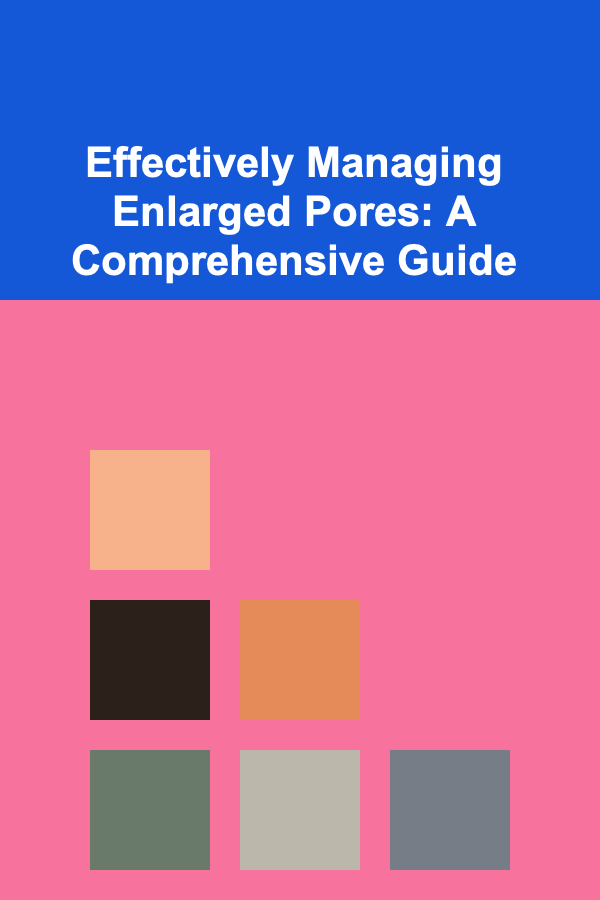
Effectively Managing Enlarged Pores: A Comprehensive Guide
ebook include PDF & Audio bundle (Micro Guide)
$12.99$5.99
Limited Time Offer! Order within the next:

Enlarged pores are a common skin concern, affecting individuals of various ages and skin types. While they are a natural feature of the skin, their prominent appearance can be a source of frustration and self-consciousness. Understanding the underlying causes of enlarged pores, adopting a consistent skincare routine, and incorporating specific treatments can significantly minimize their appearance and improve overall skin health. This comprehensive guide delves deep into the science behind enlarged pores, explores preventative measures, and outlines effective treatment strategies to achieve a smoother, more refined complexion.
Understanding the Nature of Pores
Pores are tiny openings in the skin that contain hair follicles and sebaceous glands. These glands produce sebum, a natural oil that moisturizes the skin and protects it from environmental damage. Pores play a vital role in maintaining skin health; however, their size can vary significantly from person to person, influenced by factors such as genetics, age, and skin type. It's crucial to understand that you cannot truly "shrink" pores permanently, as they are a structural component of your skin. The goal is to minimize their appearance by addressing the factors that cause them to become enlarged.
Several factors contribute to the perception of enlarged pores:
- Increased Sebum Production: Oily skin types are more prone to enlarged pores. Excess sebum accumulation within the pore can stretch its walls, making it appear larger.
- Decreased Skin Elasticity: As we age, our skin loses collagen and elastin, the proteins responsible for its firmness and elasticity. This loss of support around the pores can cause them to sag and appear more prominent.
- Sun Damage: Prolonged sun exposure damages collagen and elastin, accelerating the aging process and contributing to decreased skin elasticity and enlarged pores.
- Accumulation of Debris: Dead skin cells, dirt, and makeup can clog pores, leading to inflammation and stretching. Blackheads and whiteheads, which are essentially plugs of sebum and debris, further exacerbate the issue.
- Genetics: Pore size is often genetically predetermined. If your parents have large pores, you are more likely to have them as well.
Prevention is Key: Minimizing Pore Enlargement
While you can't change your genetics, you can take proactive steps to prevent pores from becoming more noticeable. Establishing a consistent and effective skincare routine is paramount in maintaining pore health and minimizing their appearance.
1. Gentle and Consistent Cleansing
Cleansing is the cornerstone of any good skincare routine. Choose a gentle, non-comedogenic cleanser that effectively removes dirt, oil, and makeup without stripping the skin of its natural moisture. Harsh cleansers can irritate the skin and trigger increased sebum production, potentially worsening the problem. Look for ingredients like:
- Salicylic Acid (BHA): This beta-hydroxy acid is oil-soluble, meaning it can penetrate into the pores to dissolve sebum and exfoliate dead skin cells.
- Glycolic Acid (AHA): This alpha-hydroxy acid exfoliates the surface of the skin, promoting cell turnover and preventing the build-up of dead skin cells that can clog pores.
- Tea Tree Oil: Known for its antibacterial and anti-inflammatory properties, tea tree oil can help to reduce acne-causing bacteria and inflammation within the pores. Use with caution and in diluted form, as it can be irritating for some skin types.
Cleansing Frequency: Cleanse your face twice daily -- once in the morning and once in the evening. Over-cleansing can dry out the skin and lead to irritation, so avoid washing your face more than twice a day.
2. Regular Exfoliation
Exfoliation is essential for removing dead skin cells and preventing them from clogging pores. There are two main types of exfoliation:
- Physical Exfoliation: This involves using a scrub or brush to physically remove dead skin cells. Be cautious with physical exfoliants, as harsh scrubbing can irritate the skin and even cause micro-tears. Opt for gentle scrubs with fine, rounded particles.
- Chemical Exfoliation: This involves using chemical exfoliants, such as AHAs and BHAs, to dissolve the bonds between dead skin cells. Chemical exfoliants are generally considered to be more effective and less irritating than physical exfoliants when used properly.
Exfoliation Frequency: Exfoliate 1-3 times per week, depending on your skin type and tolerance. Start slowly and gradually increase the frequency as needed. Over-exfoliating can lead to redness, irritation, and dryness.
3. Non-Comedogenic Products
Choose skincare and makeup products that are labeled as "non-comedogenic," meaning they are less likely to clog pores. Pay close attention to the ingredient lists of your products and avoid those containing ingredients that are known to be pore-clogging, such as:
- Isopropyl Myristate
- Mineral Oil
- Coconut Oil (can be comedogenic for some)
- Lanolin
Reading ingredient labels can be daunting, but several online resources and apps can help you identify potentially comedogenic ingredients in your products.
4. Sun Protection is Paramount
Sun damage is a major contributor to enlarged pores and premature aging. Protecting your skin from the sun's harmful UV rays is crucial for maintaining skin elasticity and preventing pores from becoming more prominent. Use a broad-spectrum sunscreen with an SPF of 30 or higher every day, even on cloudy days. Reapply sunscreen every two hours, especially if you are swimming or sweating.
5. Maintain a Healthy Lifestyle
A healthy lifestyle can have a significant impact on your skin's health and appearance. Factors such as diet, hydration, and stress levels can all contribute to pore size and overall skin condition.
- Diet: Eat a balanced diet rich in fruits, vegetables, and whole grains. Avoid processed foods, sugary drinks, and excessive amounts of unhealthy fats. Some studies suggest that dairy and high-glycemic index foods may contribute to acne and increased sebum production.
- Hydration: Drink plenty of water throughout the day to keep your skin hydrated and plump. Dehydrated skin can appear dull and pores may look more noticeable.
- Stress Management: Chronic stress can trigger hormonal imbalances that can lead to increased sebum production and acne breakouts. Practice stress-reducing activities such as yoga, meditation, or spending time in nature.
Effective Treatments for Enlarged Pores
While prevention is essential, several effective treatments can help minimize the appearance of existing enlarged pores and improve overall skin texture. These treatments range from over-the-counter products to professional procedures performed by dermatologists or licensed aestheticians.
1. Over-the-Counter (OTC) Treatments
Many OTC products contain ingredients that can help to improve the appearance of enlarged pores. Look for products containing the following ingredients:
- Retinoids (Retinol, Retinaldehyde, Tretinoin): Retinoids are vitamin A derivatives that are highly effective at increasing cell turnover, stimulating collagen production, and unclogging pores. They can also help to improve skin texture and reduce the appearance of fine lines and wrinkles. Start with a low-concentration retinol product and gradually increase the strength as your skin tolerates it. Retinoids can cause dryness, redness, and peeling, especially when first starting out. It is crucial to use sunscreen diligently while using retinoids, as they increase your skin's sensitivity to the sun. Tretinoin requires a prescription.
- Niacinamide (Vitamin B3): Niacinamide is a powerful ingredient that can help to reduce inflammation, control sebum production, and improve skin elasticity. It can also help to minimize the appearance of pores and even out skin tone.
- Salicylic Acid (BHA): As mentioned earlier, salicylic acid is an excellent ingredient for unclogging pores and exfoliating dead skin cells. It's particularly effective for oily and acne-prone skin.
- Charcoal Masks: Charcoal masks can help to draw out impurities and excess sebum from the pores, making them appear smaller. Use these masks sparingly, as overuse can dry out the skin.
- Clay Masks: Similar to charcoal masks, clay masks can help to absorb excess oil and impurities from the pores. Look for masks containing bentonite clay or kaolin clay.
2. Professional Treatments
For more significant results, consider consulting a dermatologist or licensed aesthetician about professional treatments for enlarged pores. These treatments are generally more powerful and effective than OTC products, but they also come with a higher cost and potential for side effects.
- Chemical Peels: Chemical peels involve applying a chemical solution to the skin to exfoliate the top layers. This can help to improve skin texture, reduce the appearance of pores, and even out skin tone. Different types of chemical peels are available, ranging in strength from superficial to deep. The choice of peel will depend on your skin type and the severity of your pore concerns.
- Microdermabrasion: Microdermabrasion is a non-invasive procedure that uses a special device to exfoliate the skin. This can help to remove dead skin cells, unclog pores, and improve skin texture. It is a less aggressive treatment than chemical peels.
- Microneedling: Microneedling involves using a device with tiny needles to create micro-injuries in the skin. This stimulates collagen production, which can help to improve skin elasticity and reduce the appearance of pores. It's often combined with the application of serums or growth factors to enhance results.
- Laser Resurfacing: Laser resurfacing is a more aggressive treatment that uses a laser to remove the outer layers of skin. This can significantly improve skin texture, reduce the appearance of pores, and address other skin concerns such as wrinkles and scars. Laser resurfacing requires a longer recovery time and carries a higher risk of side effects than other treatments. Different types of lasers exist, each with different wavelengths and energy levels. Fractional lasers are often used to minimize downtime.
- Pore Extractions: Professional pore extractions, performed by a trained aesthetician, can safely and effectively remove blackheads and whiteheads from the pores. Attempting to extract pores yourself can lead to inflammation, scarring, and further pore enlargement.
3. Choosing the Right Treatment
The best treatment for enlarged pores will depend on your individual skin type, concerns, and budget. It is crucial to consult with a dermatologist or licensed aesthetician to determine the most appropriate treatment plan for you. They can assess your skin condition, discuss your goals, and recommend the most effective and safe treatments.
Important Considerations and Potential Side Effects
Before starting any treatment for enlarged pores, it is crucial to be aware of potential side effects and take necessary precautions.
- Sensitivity and Irritation: Many treatments, especially those involving retinoids, AHAs, or BHAs, can cause sensitivity, redness, dryness, and peeling. Start with low concentrations and gradually increase the strength as your skin tolerates it. Use a gentle moisturizer to help alleviate dryness.
- Sun Sensitivity: Many treatments increase your skin's sensitivity to the sun. It is essential to wear sunscreen diligently every day, even on cloudy days.
- Allergic Reactions: Always perform a patch test before using a new product to check for allergic reactions. Apply a small amount of the product to a discreet area of skin, such as behind the ear, and wait 24-48 hours to see if any irritation occurs.
- Post-Inflammatory Hyperpigmentation (PIH): Some treatments, especially those involving exfoliation or laser resurfacing, can cause PIH, which is a darkening of the skin after inflammation. This is more common in individuals with darker skin tones. Using sunscreen and avoiding sun exposure can help to prevent PIH.
- Scarring: In rare cases, aggressive treatments such as laser resurfacing can lead to scarring. Choose a qualified and experienced professional to perform these procedures to minimize the risk of complications.
- Pregnancy and Breastfeeding: Some treatments, such as retinoids, are not safe to use during pregnancy or breastfeeding. Consult with your doctor before using any new products or treatments during these times.
Conclusion: Consistency and Patience are Key
Managing enlarged pores effectively requires a consistent and patient approach. There is no quick fix or overnight solution. By understanding the causes of enlarged pores, adopting a proactive skincare routine, and incorporating appropriate treatments, you can significantly minimize their appearance and improve the overall health and appearance of your skin. Remember to consult with a dermatologist or licensed aesthetician to determine the best treatment plan for your individual needs. Embrace the journey, be patient with your skin, and celebrate the progress you make along the way. Focus on overall skin health and radiance, rather than fixating solely on pore size. With dedication and the right approach, you can achieve a smoother, more refined complexion and boost your confidence.

How to Organize Holiday Decorations to Avoid Clutter
Read More
How to Organize Your Home While Decorating on a Budget
Read More
How to Protect Your Home from the Inside with Security Tips
Read More
Lowering Car Insurance Premiums: What You Need to Know to Cut Costs
Read More
How To Use a Tripod for Sharper Images: A Comprehensive Guide
Read More
Feng Shui Colors: Choosing Hues for Different Energies
Read MoreOther Products

How to Organize Holiday Decorations to Avoid Clutter
Read More
How to Organize Your Home While Decorating on a Budget
Read More
How to Protect Your Home from the Inside with Security Tips
Read More
Lowering Car Insurance Premiums: What You Need to Know to Cut Costs
Read More
How To Use a Tripod for Sharper Images: A Comprehensive Guide
Read More